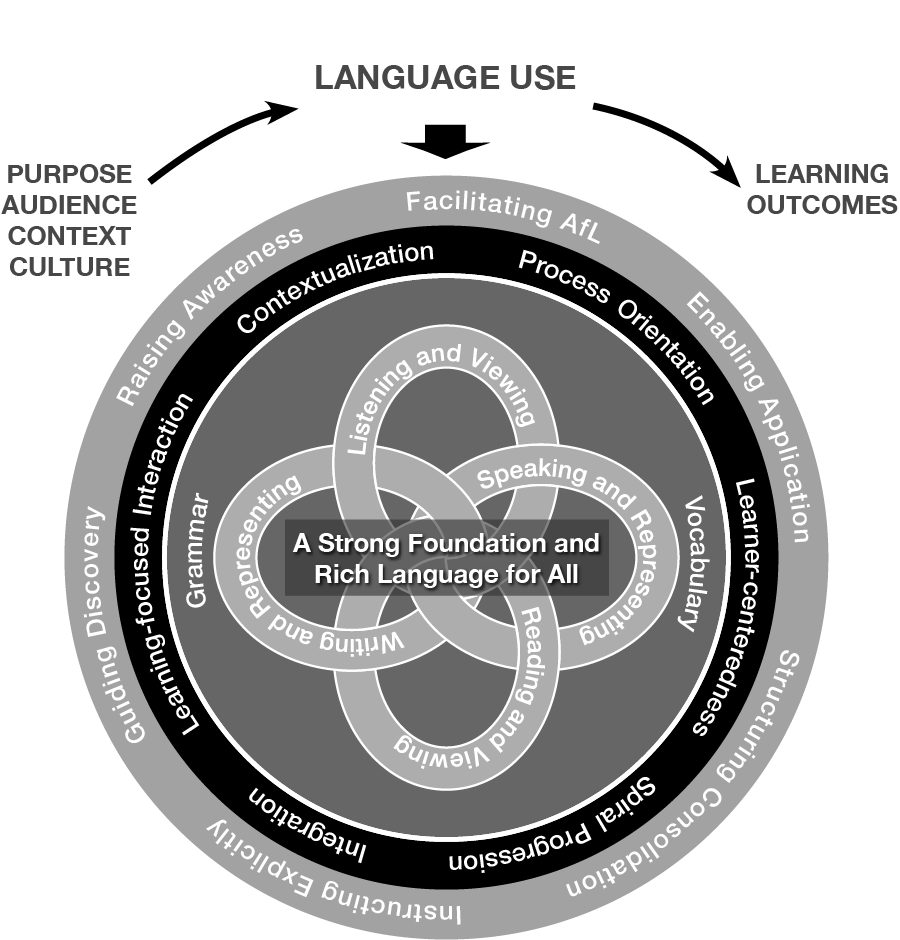Language/Reading Curriculum in the Fourth Grade
Reading Policy
Literacy development is at the heart of Singaporean schools’ English instructional program. The objective of teaching English is to help students achieve a level of competency that will enable them to use English effectively and appropriately based on purpose, audience, context, and culture. Effective language use is achieved through “A Strong Foundation and Rich Language for Allˮ approach, which emphasizes building a strong foundation in language and enriching language learning for all students. The cognitive and affective engagement and social interaction involved in language learning are achieved through the integrated teaching of listening, speaking, reading, and writing skills. All students are expected to be able to speak, read, and write in English by the time they leave primary school.
Summary of National Curriculum
In line with the regular cycle of syllabus revision, the English Language Syllabus 2010 (ELS2010) has replaced the English Language Syllabus 2001.19 ELS2010, the current national syllabus, was implemented progressively from Grade 1 (Primary 1) in 2010 to Grade 6 in 2015, and was in effect for most Grade 4 students assessed in PIRLS 2016. With an emphasis on an integrated approach to language learning and literacy development, the goal of ELS2010 is to help students become independent lifelong learners, creative thinkers, and problem solvers who can communicate effectively in English (see Exhibit 2). ELS2010 aims to help students develop in the following areas of language learning:
- Listen, read, and view critically and with accuracy, understanding, and appreciation a wide range of literary and informational/functional texts from print and nonprint sources
- Speak, write, and represent ideas in internationally acceptable English that is grammatical, fluent, mutually intelligible, and appropriate for different purposes, audiences, contexts, and cultures
- Understand and use internationally acceptable English grammar and vocabulary accurately and appropriately; understand how speakers and writers use language to communicate meaning and achieve impact
Exhibit 2: Key Features of the English Language Syllabus 201020

To achieve the aims of effective language use, teachers are guided by the principles of English teaching and learning, taking into account the teaching processes when developing instructional programs and lessons (see Exhibit 3).
Exhibit 3: Principles and Teaching Processes of English Teaching and Learning21
| Principles of English Teaching and Learning (CLLIPS) | |
| Contextualization |
|
| Learner-Centeredness |
|
| Learning-Focused Interaction |
|
| Integration |
|
| Process Orientation |
|
| Spiral Progression |
|
| Teaching Processes of English Teaching and Learning (ACoLADE) | |
| Raising Awareness |
|
| Structuring Consolidation |
|
| Facilitating Assessment for Learning |
|
| Enabling Application |
|
| Guiding Discovery |
|
| Instructing Explicitly |
|
In the initial primary school years, students learn to read. As they move to the middle and upper primary levels, they read to learn. The syllabus is organized around areas of language use and focuses on exposure to and the study of a wide range of texts. Learning to read, view, enjoy, respond to, and understand critically a variety of print and nonprint texts helps students progressively achieve fluency in reading and viewing in order to learn in the content areas.
In primary schools, the Strategies for English Language Learning and Reading (STELLAR) program aims to develop in students a strong foundation in the English language and a love for reading. This program supports schools by providing the pedagogic framework for lesson design and instructional materials for implementing ELS2010. It recommends a variety of print and nonprint resources from genres such as literary and informational/functional texts to provide authentic contexts for teaching and language learning. Print resources such as newspaper articles, print advertisements and photographs, and digital resources such as Web-based texts, videos, and audio texts are used. As they progress through the grade levels, students use English at increasing levels of difficulty and sophistication.
At all grade levels, significant attention is given to promoting reading for enjoyment. Students are encouraged to read widely and learn to analyze and evaluate what they read. ELS2010 advocates the use of reading strategies such as decoding through phonics, close reading and viewing, critical reading, viewing and appreciation, and extensive reading and viewing. In school, students receive guidance through activities that involve skills and meaning-based instruction, incorporating phonics, word recognition, whole text, and intertextual comprehension. Reading and viewing skills are organized into three focus areas:
- Reading Comprehension and Viewing Skills, Strategies, Attitudes, and Behavior—These are organized over three progressive stages:
Stage 1: Beginning Reading Students who are learning to read are guided using teacher supported strategies. Modeling is done through reading aloud before moving toward independent silent reading with greater fluency. Stage 2: Close Reading and Viewing Students learn to read closely to infer meaning and process information. Stage 3: Critical Reading and Viewing Students learn to read critically for implied meaning and develop judgment, higher-order thinking, and evaluation skills. Teachers encourage students to compare texts against one another to make critical connections to what is read and viewed. - Reading and Viewing of Different Types of Rich Texts—Students apply critical reading and viewing skills and strategies to appreciate how language works in different texts. This enables students to move from reading to writing with greater ease.
- Opportunities for Extensive Reading and Viewing—Exposure to a wide range of rich texts that model good writing and use of language builds students’ language skills and general knowledge of the world, moving them toward reading independence and fluency. To develop reading skills, teachers need to recognize that students learn in many different ways and progress at different rates.
